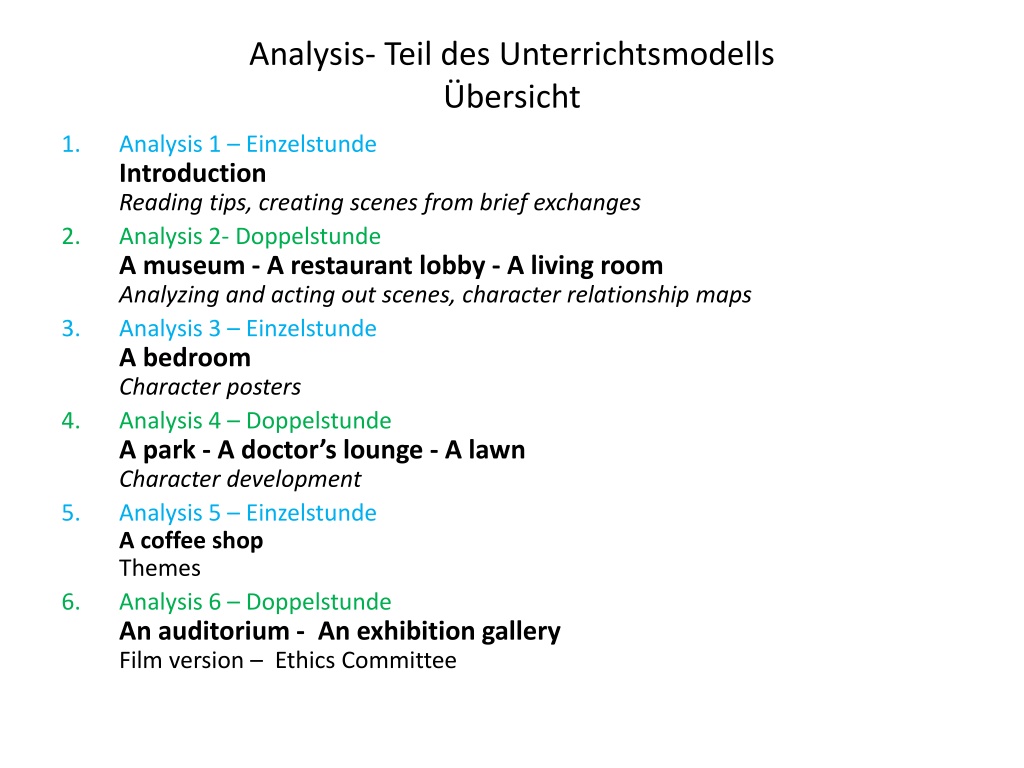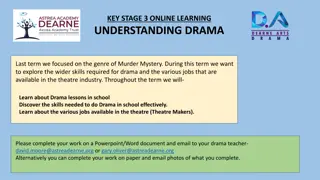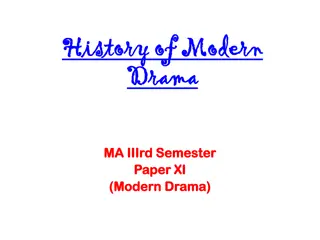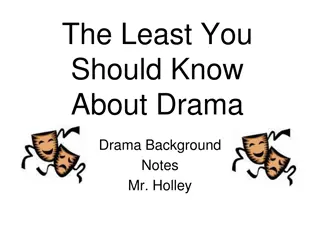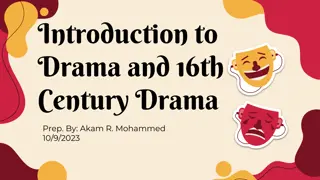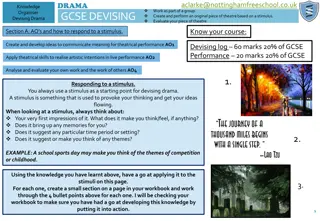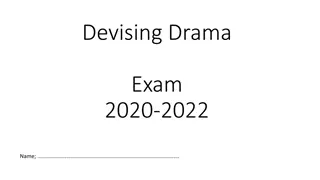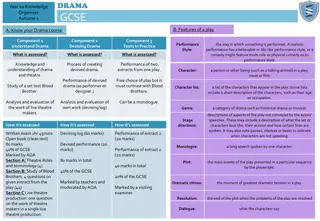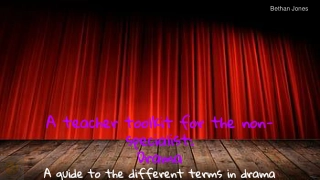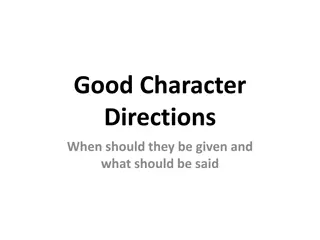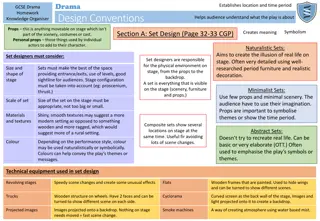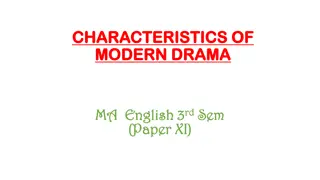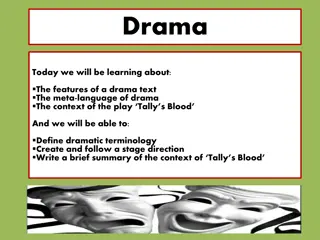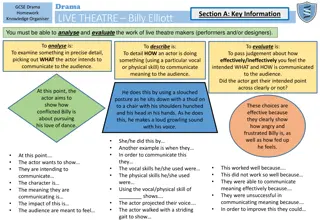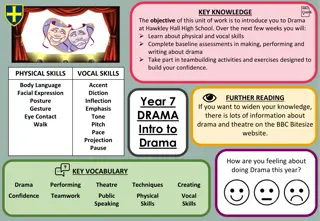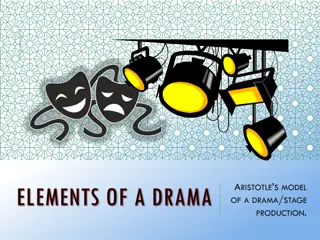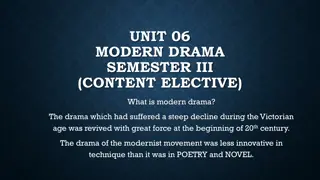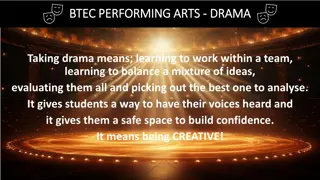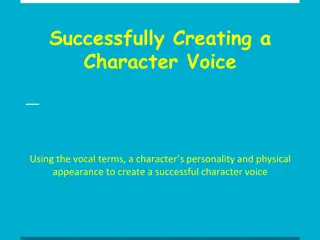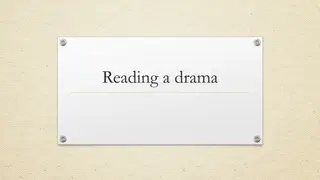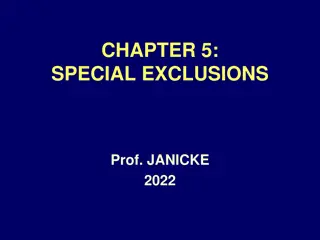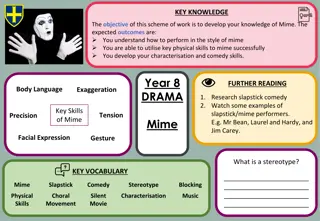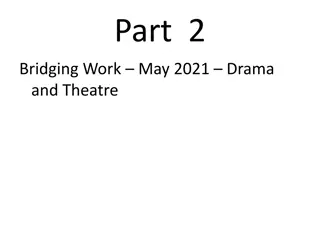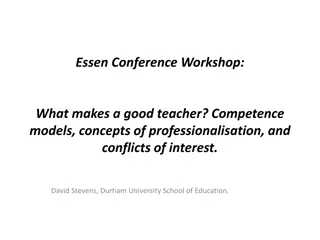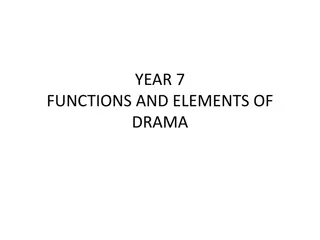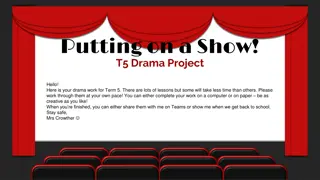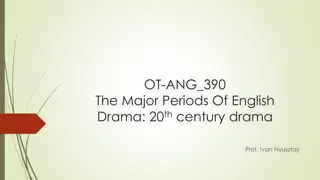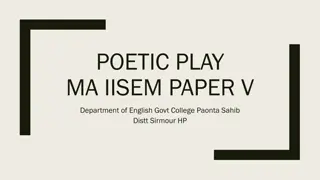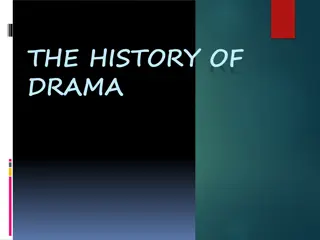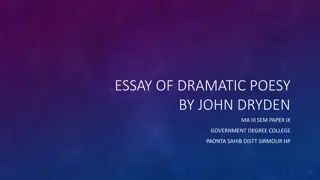Drama Exploration and Character Development in Teaching Models
Explore the structure of drama teaching models featuring Neil LaBute's works. Engage students in analyzing characters, creating scenes, and developing thematic elements. Foster creativity through acting out scenarios and discussing ethical dilemmas. Encourage active reading strategies with bookmarks and character visualization exercises. Dive into critical moments in life, conflict resolution, and decision-making processes through theatrical exploration.
Uploaded on Oct 05, 2024 | 0 Views
Download Presentation

Please find below an Image/Link to download the presentation.
The content on the website is provided AS IS for your information and personal use only. It may not be sold, licensed, or shared on other websites without obtaining consent from the author. Download presentation by click this link. If you encounter any issues during the download, it is possible that the publisher has removed the file from their server.
E N D
Presentation Transcript
Analysis- Teil des Unterrichtsmodells bersicht 1. Analysis 1 Einzelstunde Introduction Reading tips, creating scenes from brief exchanges Analysis 2- Doppelstunde A museum - A restaurant lobby - A living room Analyzing and acting out scenes, character relationship maps Analysis 3 Einzelstunde A bedroom Character posters Analysis 4 Doppelstunde A park - A doctor s lounge - A lawn Character development Analysis 5 Einzelstunde A coffee shop Themes Analysis 6 Doppelstunde An auditorium - An exhibition gallery Film version Ethics Committee 2. 3. 4. 5. 6.
Analysis 1 - Einzelstunde Introduction to The Shape of Things bersicht 1. Einzelne S stellen ihr outline f r drama plots/characters/conflict auf der Grundlage der Themen der ersten Doppelstunde vor (Hausaufgabenbesprechung) Kurze Lehrerinfo zu Autor und Werk, das in den folgenden Wochen im Zentrum steht Motivation und Leseerziehung durch Einf hrung der bookmarks und der stop and think cards (bookmarks f r Hausaufgabe wichtig) Kurze Lehrerinfo zur Bedeutung von Dialog im Drama Drama activity: creating scenes from brief exchanges Kreative Aktivierung Hausaufgabe: Reading Portion 1: A museum A restaurant lobby - A living room Leseauftrag gem bookmark 2. 3. 4. 5. 6.
You are the playwright! Please present the ideas for your short plays. Focus on: characters and what they stand for, plot: conflict/dilemma situations/critical moments in life, choices/decisions.
Neil LaBute Born 1963 in Detroit, Michigan Degrees in theater and film One of the most prolific, controversial and successful contemporary dramatists Has written and directed more than 20 plays, has successfully adapted some of his plays into movies, turned his attention to TV work .. World Premiere The Shape of Things May 2001 The Almeida, London met with critical acclaim, (Drama Desk Award for Outstanding Plays in 2001), continues being staged in theatres all over the world 4
Reading Drama Bookmarks Stop and Think Cards Reading Drama How to help the 'real' people to grow out of the words on the page. Visualize the characters. What do they look like? How do they move? How do they sound? What current movie star would be best to play the role? Visualize the setting. What color is the sculpture (A museum), the couch (A living room)? Read with a pencil. Record your reactions as you read. Use a notebook or a journal. If there are parts which you don't understand, read the lines aloud. Visualize what an actor would look like speaking the lines. Spot your personal quote "Because I don't like art that isn't true." Stop and Think Card Who is speaking? Where are they? What is the situation in detail? What are the relationships? Who is more dominant? What do the words say? What do they mean? Choose one character, walk in his/her shoes. Why am I saying what I'm saying? Because I want Because I think... Because I feel... Because this is what I'm like...
Drama Activity Creating scenes from brief exchanges Dialogues Monologues Plays are made from what people say to themselves, to the audience, to a prop. Plays are made from what people say to one another.
Drama Activity Creating scenes from brief exchanges A play is not real life, but good speech in a play should have something of everyday speech. Procedure 1. Stand in a circle in As and Bs 2. Read your lines around the circle: A opens the exchange, B replies 3. Try to find the other half of your play by trying your line out on as many other people as possible 4. Once all of you have found their partners, each pair reads the result to the rest of the group Meaning can be imposed on any random utterance, an entire scene can be created from one very brief exchange.
Drama Activity Creating scenes from brief exchanges Expand your plays by adding more lines B adds one line to go before the original A line A Optional: you add one more line each at the beginning and at the end B A adds one line to go after the original B line
Reading Drama Reading Portion 1 Using the instructions on your bookmark read the first 3 scenes of The Shape of Things A museum A restaurant lobby A living room
Analysis 2 - Doppelstunde A museum - A restaurant lobby A living room bersicht 1. 2. S nennen ihre Leseerfahrungen Who is it (which character)? What s the context? (Comprehension) Features of conversation (sensitizing for use of natural conversation/dialogue) Kurzes Lehrerinfo zu characters in a drama, story and plot (difference) Analysis: setting/props characters plot (arbeitsteilige Gruppenarbeit, je eine Szene) Analysis/Creative: Acting out scenes (je einen kleinen Teil einer Szene A Living Room ) Feedback/Think Tank Character relationship map ( A Living Room ) Hausaufgabe: Reading portion 2: A bedroom. Task: 1. Writing as prediction: Write down what will happen next 2. While reading write comments in the margin 3. 4. 5. 6. 7. 8. 9.
Comprehension A museum - A restaurant lobby A living room Who .. 1. asks somebody to step back? 2. doesn t like art that isn t true? 3. has just started on a thesis project, an installation thingie ? 4. is wearing something which is not part of the uniform? 5. might have a split personality? 6. is said to have a great ass? 7. doesn t think his buddy is ever going to get married? 8. talks about vandalism? 9. mentions the rights of females to speak on their own? 10. is clearly unhappy about the escalation of an argument?
Features of conversation Feature Example Effect if used in literary texts Hesitation Oh well Me, I s pose? Incomplete elements No I m gonna So, yeah, alright. It s a whole routine thing. Your re right . Interruption/Overlapping A: You stepped over the line. Miss?/Umm, you stepped over . E: I Know/It s ms. Reformulation No .. I mean, yes ..
Features of conversation Feature Example Effect if used in literary texts Echoing speech A: Another time, we ll definitely discuss it. E: Another time ..I d rather do it. Vague or inaccurate vocabulary No, he cut his hair Or something. Ummm, yeah. I mean, both, sort of. Beat (short pause) I d get fired for doing my job. Screw that .. (Beat) . Could you do that for me though?
A museum A restaurant lobby A living room Analysis: setting/props characters - plot setting/props characters plot drama terms
Setting/props 1. Setting: where and when? 2. The play is divided into (acts and) scenes. Do they correspond to action, time, place or a combination of these? 3. How does the setting influence the atmosphere? 4. Does the script contain stage directions? If so, what information do they provide? If so, do they draw a concise picture of the scenery/room etc.? 5. Does the play work with props or is there a bare stage? 6. If there are props, why and how do the actors use them? What is the effect? Is it symbolic?
Characters Plays are about people. But characters in plays are not people and they are not whole. They just suggest the complexity of a real person. The characters carry the action forward. They grow and develop. Some appear as friendly characters at first, but later turn out to be villains or morally questionable, ambiguous characters. Sometimes they stand for a particular idea or are part of the play s message . However, what characters do and say sometimes affects us deeply. We feel with the characters, we care, we connect.
Plot Before a story can become a play, it must first become a plot Plot Story The plot tells us why The story tells us what happened The king dies and then the queen dies of grief. E.M. Forster: The plot is also a narrative of events, the emphasis falling on causality. The king dies and then the queen dies. E.M. Forster: The story is a narrative of events arranged in their time sequence. The crucial element of causality can be developed and creates drama. We don t just want to know what happens, we want to know why.
A museum A restaurant lobby A living room Analysis: setting/props characters - plot 1. Setting and props Analytical: Where and when (in relation to the other scenes) does the scene take place? Creative: Visualize setting and props, describe/sketch what you see (e.g. architecture, furniture, colors, shapes .). Characters Analytical: Who are the characters? What do we learn about them through what they say and what they do, through what others say about them? Creative: Visualize the characters. What famous movie/TV/YouTube star would be best to play the role? How do they move? How do they sound? Plot Analytical: What s going on? How does the plot develop through dialogue and how do the characters carry the action/the conflict of the play forward? Fast finishers: Visualize the character constellation in A living room 2. 3.
PLot Which character(s) carries/carry the action forward . by doing/saying/ what?
Acting out scenes: step 1 Who? What? Why? You are actors discussing the scene using a simple set of questions: Why? Who? Why do you think the characters say what they say, and behave as they do? What does each one want/think/feel? What? Who are these characters? Briefly talk about your impression of each one what is he or she like? What s going on? Briefly discuss what you think is happening. What do the words say? What do they mean? Why do the characters saying what they say?
Acting out the scenes: step 2 Lifting the words off the page How can we lift these words off the page to act out a performance that will really hold an audience? Discuss the following questions: Where is your audience? Where is each character in relation to the others at the start of the scene? Where do they move to as the scene proceeds? How does the speaking character behave? How do the others react? How does the characters speak their lines? Details to be considered include voice, pauses, emphasis, facial expression, gesture and movement. 1. 2. 3. 4.
Feedback Team: Audience: Audience: Is that what you wanted to show? Why did the characters say what they were saying? Because they want/think/feel . How/to what extent did the team succeed in conveying this? What did you want to show?
Think Tank How could we visualize your findings? Give three reasons why you like/dislike a certain character What are the relationships? Manifesto or vandalism What is your opinion? Which conflict(s) can you detect? Who is more dominant?
Manifesto or vandalism? it was a sort of statement it was a gesture, a kind of manifesto it was pornography a person s dick can be no manifesto
In the living room: Analysis Character Relationship Map Visualize the character constellations in this scene in a character relationship map using symbols, quotes and descriptions. Adam Evelyn Phillip Jenny
Reading Portion 2: A Bedroom Writing as prediction / Comments in the margin Material: A bedroom on a handout with plenty of space around it. Task: 1. Before reading, write down in detail what will happen next 2. While reading, write your reactions in the margin. You will not have to discuss your reactions. Feel free to write whatever you want.
Analysis 3 - Einzelstunde A bedroom bersicht 1. What are your favourite lines? Comprehension 2. Character Posters Character Analysis, Visualisierung
Creating character posters 1. Collect everything you can learn about your character: appearance, actions, personality, (perceived) thoughts/feelings/likes/dislikes/ dreams/regrets/fears, back story (what do we learn about the character s past?) 2. Match your findings to body parts, e.g. feelings heart, thoughts head, inside the body: the character s own feelings etc.; outside the body: comments made by other characters
Character posters 1. Compare your character posters (all Adams, all Evelyns ..). 2. Describe similarities and differences. 3. Add to your poster if you gained any new insights and think they might improve your own findings. 4. Present one poster of your choice and inform the class about aspects you (dis)agreed on.
Reading Portion 3 A park A doctor s lounge A lawn Structure your notes so that you can add your new insights to your character poster in the next lesson Read the next three scenes Take notes on how your character develops
Analysis 4 - Doppelstunde A park A doctor s lounge A lawn bersicht 1. Comprehension Matching words/phrases with scenes 2. Character Posters Revisited 3. Adam s transformation Gallery Walk Visualization Presentation (Feedback)
Comprehension Match the words/phrases with the scenes A park A doctor s lounge A lawn Phillip - Evelyn Jenny contacts - E.A.T. - cosmetic, not corrective - somebody being lovely - a wall between two people - yachtsman - somebody being sweet - a missing jacket - a battered wife - a sadist - tripping - the Messiah - burying something in the woods - a totally hot guy - a lie - somebody not in control for the first time - not in the inner circle any more - a kiss on the cheek - a marriage idea which turns freaky - the truth - a very straightforward person - one of those peoples - a metamorphosis - a real kiss - the Jewish slope - somebody being pretty amazing - Frankenstein s monster - the new you - an old longing - nails - sitting on a bench - a last meal - a big word - a tattoo - somebody checking the bathroom ..
Character Posters Revisited after having read A park A doctor s lounge A lawn Please compare and discuss the information you collected while reading at home with your team members Add the information you as a team agreed upon to your character poster Present the additions to the class
Lets focus on Adam Adam s transformation Why does Adam change? What motivates him? How does Adam develop? Characters grow and develop along with the plot. Sometimes their identities are fluid Sometimes they are people about whom we care As causality creates drama, we want to know why. What motivates a character s development? How? Why?
Adams transformation What needs to be done? On the basis of the Adam character posters 2 4 Discuss Adam s development Present and discuss your findings 1 3 Collect even more evidence from the text Discuss Adam s and the other characters role in this process Visualize the findings (in a coherent, analytical text) Gallery Walk Presentation/ Analytical Writing Think Tank
Gallery Walk Either .. in case you want to move around and work with a limited number of quotes Or . in case you want to deal with a large number of quotes With a partner or in small teams, walk around the room and read the different texts. Match the texts to the scenes. Which ones go with A museum , which ones with A lawn etc. Try to find more quotes in the text Do the same with the snippets A museum A restaurant lobby A living room A bedroom A park A doctor s lounge A lawn
Think Tank Please visualize your findings Assess the other characters roles in this process. Plot needs causality . Analyze why this is happening to Adam. Round characters develop. Describe Adam s development. Assess Adam s role in this process.
Structuring Visualization 1 Clusters links between ideas/concepts, characters flowchart sequence of events; choices; processes line chart development over time
Structuring Visualization 2 tree diagram relationships between concepts/ideas, characters umbrella terms fishbone diagram cause and effect Venn diagram similarities and differences comparing options
Structuring Visualization 3 The road of life The tree of life Characters lives as roads. Imagine the kind of road Adam is taking: direct, uncomplicated, wide, narrow, highway, alley, lane street, way avenue, cul-de-sac, dead end ... Characters lives as trees. Which tree is Adam? What are his roots ? How thick is the trunk? How numerous are the branches? When/why/how does he develop new branches? How can you label them?
Reading Portion 4 Read A coffee shop and prepare reading out one role aloud Jenny Adam Evelyn A coffee shop
Analysis 5 - Einzelstunde A coffee shop bersicht 1. Pr sentation einzelner excerpts aus A coffee shop dramatic reading/comprehension 2. Key themes Think tank
Dramatic Reading What do the words say? What do they mean? Why do the characters saying what they say? What does each one want/think/feel? In teams of three choose an excerpt from A coffee shop which you would like to read out to the class because you find it interesting Tell the class why you have chosen this extract. Prepare and practise dramatic reading In which way is it important for analyzing our drama? Present roughly 10-15 lines
Key Themes / Think Tank Task: 1. Find out how some of these key themes occur in the scene A coffee shop . 2. Are there any other themes you can detect? betrayal and forgiveness deception and honesty jealousy and trust transformation and resistance authenticity and manipulation
Analysis 6 - Doppelstunde An auditorium An exhibition gallery bersicht 1. Textrezeption ber das Medium Film Fist reactions 2. Comprehension/(Analysis) 3. Pers nliche Stellungnahme 4. Ethics Committee Analysis/Interpretation/Presentation
Film Version THE SHAPE OF THINGS Director: Neil LaBute Cast: Paul Rudd, Rachel Weisz, Gretchen Mol, Fred Weller A Restaurant Lobby A Living Room A Museum A Doctor s Lounge A Bedroom A Park A Coffee Shop An A Lawn Auditorium Studio: Focus First Date: 2003 An Exhibition Gallery 47
Lets clarify what is happening What do we learn about .. Adam and Phillip? Phillip and Jenny Adam and Jenny? Evelyn s motivation for and justification of her thesis? Evelyn s thesis? Adam s reaction?
How do you think/feel about what Evelyn did? Everything I did made you a more desirable person People began to notice you, take interest in you. There s gotta be a line. For art to exist, there has to be a line out there somewhere.
College Ethics Committee Analysis/Interpretation For a hearing prepare either Evelyn s or Adam s statement 1. Collect arguments from the text, arrange them 2. While staying true to your character, you may elaborate on the arguments found in the text. Add feelings and, especially in Adam s case, consequences for Adam s life 3. Write an outline of your speech How to grade it? Honor her work or expel her? Accept it or refuse it? Evelyn s thesis
